In pics: Base camp of northern face of Mt. Qomolangma in China's Tibet
Xinhua
1557709174000

Seracs are seen at the foot of Mount Qomolangma in southwest China's Tibet Autonomous Region, April 19, 2019. Every year, for a few weeks, hundreds of climbers and supporting personnel come to the base camp of the northern face of Mount Qomolangma, trying to reach the summit of the tallest and most famous mountain in the world. Before starting climbing, they need to hike several times between elevations from 5,000 meters to 7,000 meters, giving their bodies some time to adapt. When this process is over, it's all up to the weather. The base camp is a popular place to wait for the window. Among the six camps on the northern face, the base camp at an altitude of 5,200 meters is the furthest cars can reach and therefor the most equipped. Besides food and accommodation, climbers can also enjoy tea and massage. They can also play football on perhaps the highest field. There's even a simple gym in the camp. Environmental protection is a priority here. Garbage sacks are given to each climbing team. Special containers are put in every camp to collect trash and sewage. The collected trash must be treated 100 kilometers away, and the only road is a zigzagging track. It is not trucks, but yaks that are generally used to make the journey. Actually yaks are vital on the mountain. Beyond the base camp, yak is the only reliable transport. (Xinhua/Zhaxi Tsering)
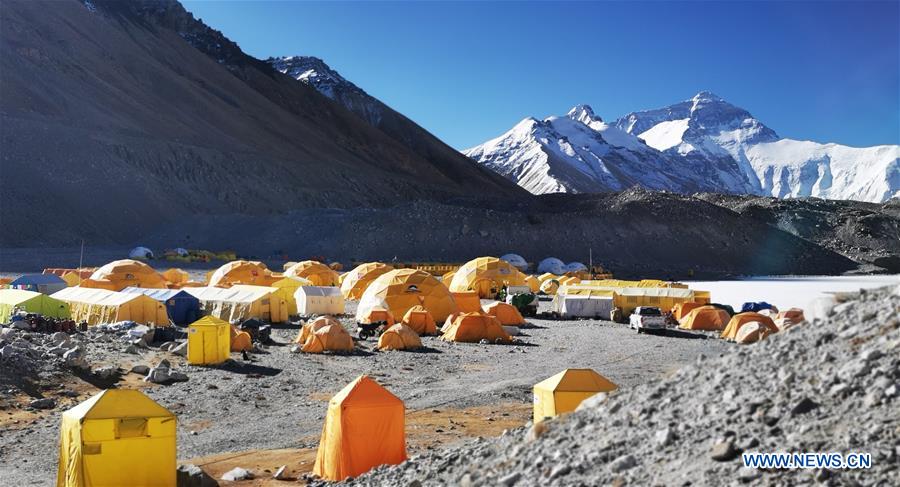
Photo taken on April 29, 2019 shows the base camp of the northern face of Mount Qomolangma in southwest China's Tibet Autonomous Region. (Xinhua/Zhaxi Tsering)
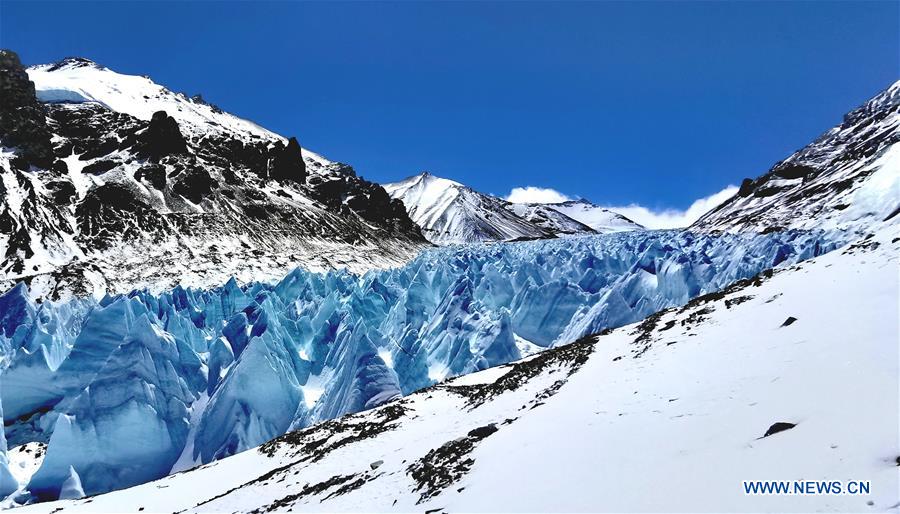
Seracs are seen at the foot of Mount Qomolangma in southwest China's Tibet Autonomous Region, April 19, 2019. (Xinhua/Zhaxi Tsering)
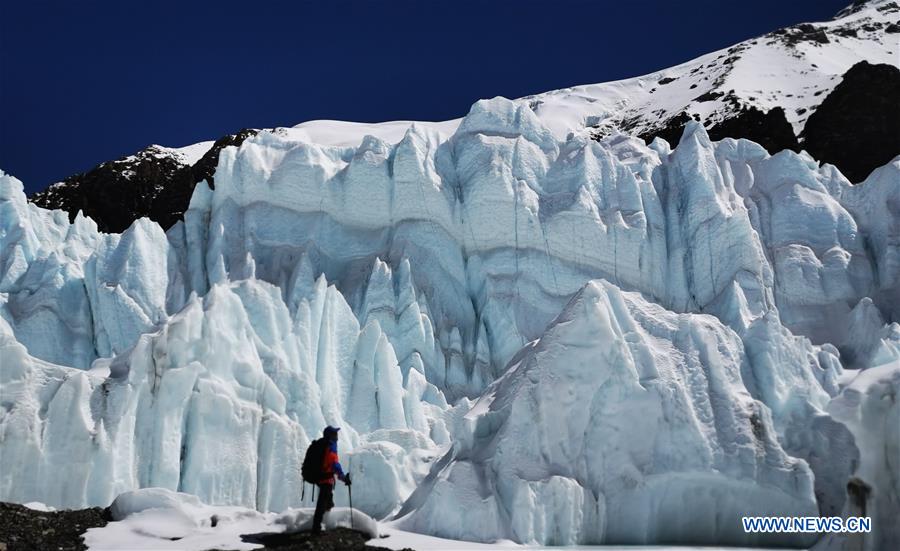
A climber is seen in front of a glacier on Mount Qomolangma in southwest China's Tibet Autonomous Region, April 26, 2019. (Xinhua/Zhaxi Tsering)
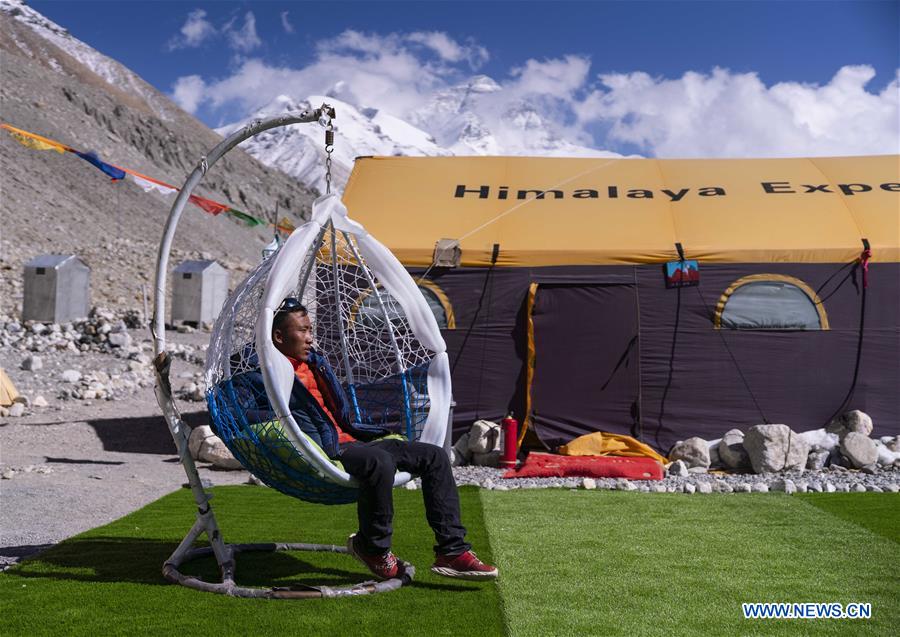
The mountain guide Sonam Tsering takes a break at the base camp of the northern face of Mount Qomolangma in southwest China's Tibet Autonomous Region, April 26, 2019. (Xinhua/Sun Fei)
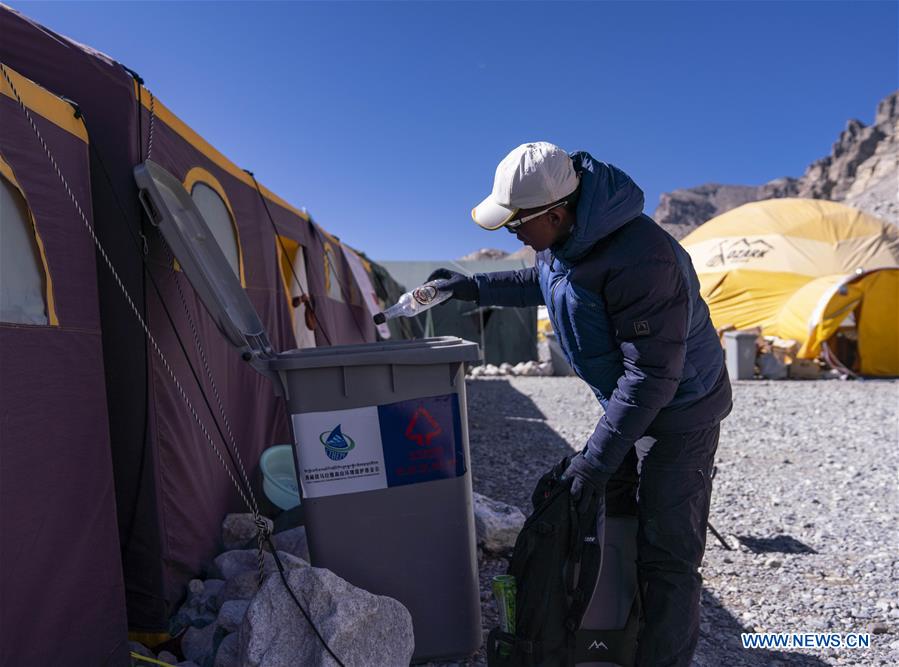
The mountain guide Sonam Tsering throws the garbage into the trash can at the base camp of the northern face of Mount Qomolangma in southwest China's Tibet Autonomous Region, April 26, 2019.
(Xinhua/Sun Fei)

Goods and materials are to be transported to the camps at higher altitude for the climbers on the northern face of Mount Qomolangma in southwest China's Tibet Autonomous Region, April 25, 2019.
(Xinhua/Sun Fei)
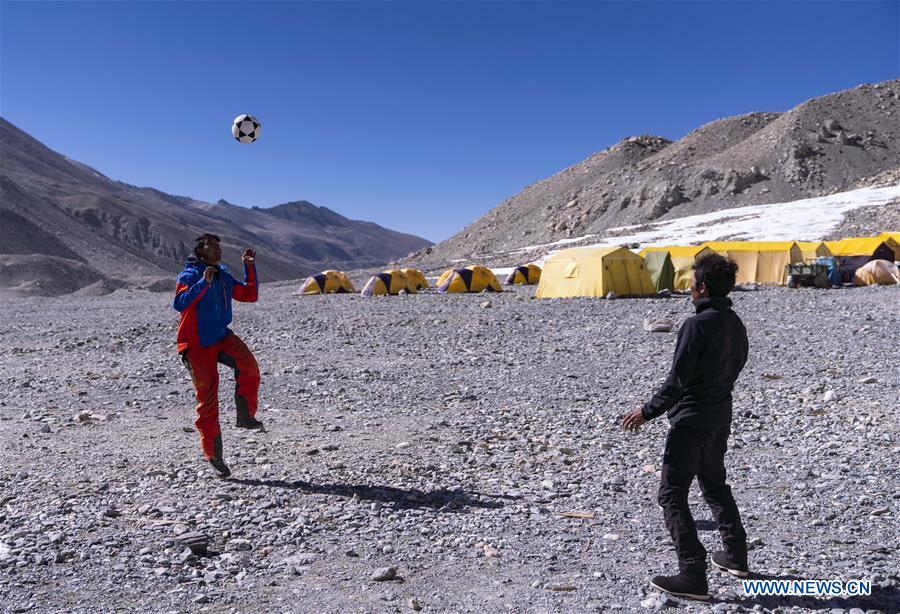
The mountain guide Zhaxi Dondrup plays football at the base camp of the northern face of Mount Qomolangma in southwest China's Tibet Autonomous Region, April 26, 2019. (Xinhua/Sun Fei)
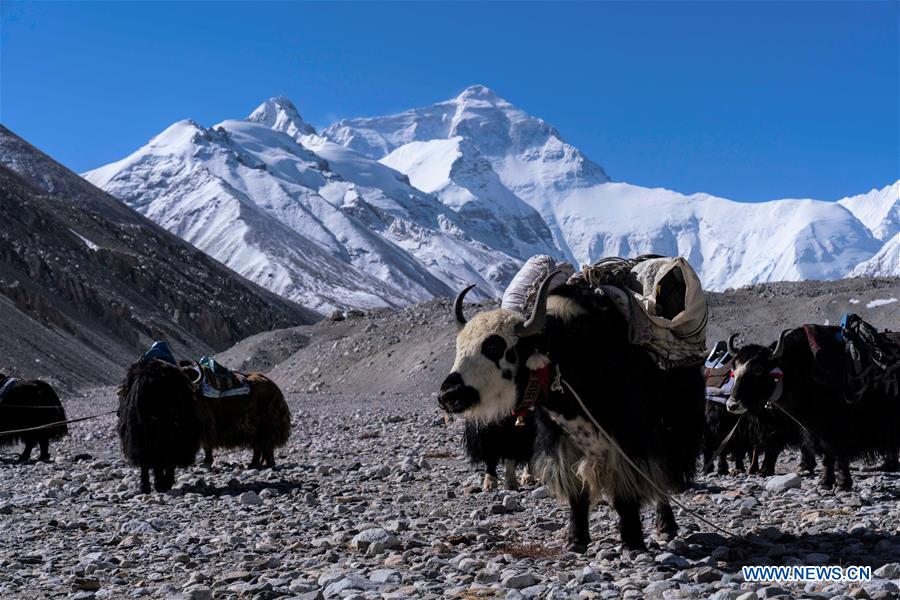
Yaks transport goods and materials to camps at higher altitude for the climbers on the northern face of Mount Qomolangma, southwest China's Tibet Autonomous Region, April 25, 2019.
(Xinhua/Sun Fei)

Climbers carry out adapting training on the northern face of Mount Qomolangma in southwest China's Tibet Autonomous Region, April 25, 2019. Every year, for a few weeks, hundreds of climbers and supporting personnel come to the base camp of the northern face of Mount Qomolangma, trying to reach the summit of the tallest and most famous mountain in the world. Before starting climbing, they need to hike several times between elevations from 5,000 meters to 7,000 meters, giving their bodies some time to adapt. When this process is over, it's all up to the weather. The base camp is a popular place to wait for the window. Among the six camps on the northern face, the base camp at an altitude of 5,200 meters is the furthest cars can reach and therefor the most equipped. Besides food and accommodation, climbers can also enjoy tea and massage. They can also play football on perhaps the highest field. There's even a simple gym in the camp. Environmental protection is a priority here. Garbage sacks are given to each climbing team. Special containers are put in every camp to collect trash and sewage. The collected trash must be treated 100 kilometers away, and the only road is a zigzagging track. It is not trucks, but yaks that are generally used to make the journey. Actually yaks are vital on the mountain. Beyond the base camp, yak is the only reliable transport. (Xinhua/Sun Fei)

Climbers warm themselves in the tent of the Chinese mountaineering team at the base camp of the northern face of Mount Qomolangma in southwest China's Tibet Autonomous Region, April 25, 2019. Every year, for a few weeks, hundreds of climbers and supporting personnel come to the base camp of the northern face of Mount Qomolangma, trying to reach the summit of the tallest and most famous mountain in the world. Before starting climbing, they need to hike several times between elevations from 5,000 meters to 7,000 meters, giving their bodies some time to adapt. When this process is over, it's all up to the weather. The base camp is a popular place to wait for the window. Among the six camps on the northern face, the base camp at an altitude of 5,200 meters is the furthest cars can reach and therefor the most equipped. Besides food and accommodation, climbers can also enjoy tea and massage. They can also play football on perhaps the highest field. There's even a simple gym in the camp. Environmental protection is a priority here. Garbage sacks are given to each climbing team. Special containers are put in every camp to collect trash and sewage. The collected trash must be treated 100 kilometers away, and the only road is a zigzagging track. It is not trucks, but yaks that are generally used to make the journey. Actually yaks are vital on the mountain. Beyond the base camp, yak is the only reliable transport. (Xinhua/Sun Fei)
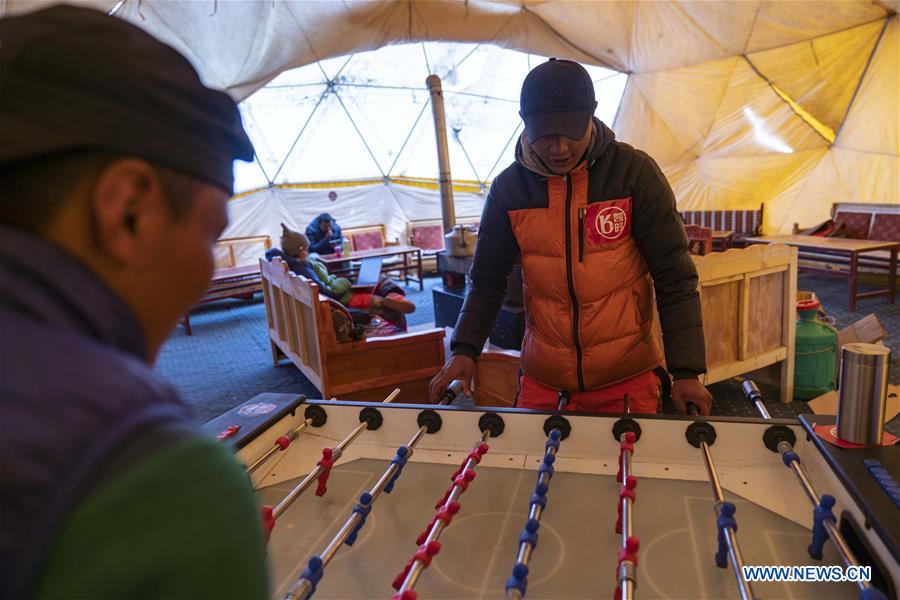
Climbers play table football in the tent of the Chinese mountaineering team at the base camp of the northern face of Mount Qomolangma in southwest China's Tibet Autonomous Region, April 25, 2019. Every year, for a few weeks, hundreds of climbers and supporting personnel come to the base camp of the northern face of Mount Qomolangma, trying to reach the summit of the tallest and most famous mountain in the world. Before starting climbing, they need to hike several times between elevations from 5,000 meters to 7,000 meters, giving their bodies some time to adapt. When this process is over, it's all up to the weather. The base camp is a popular place to wait for the window. Among the six camps on the northern face, the base camp at an altitude of 5,200 meters is the furthest cars can reach and therefor the most equipped. Besides food and accommodation, climbers can also enjoy tea and massage. They can also play football on perhaps the highest field. There's even a simple gym in the camp. Environmental protection is a priority here. Garbage sacks are given to each climbing team. Special containers are put in every camp to collect trash and sewage. The collected trash must be treated 100 kilometers away, and the only road is a zigzagging track. It is not trucks, but yaks that are generally used to make the journey. Actually yaks are vital on the mountain. Beyond the base camp, yak is the only reliable transport. (Xinhua/Sun Fei)
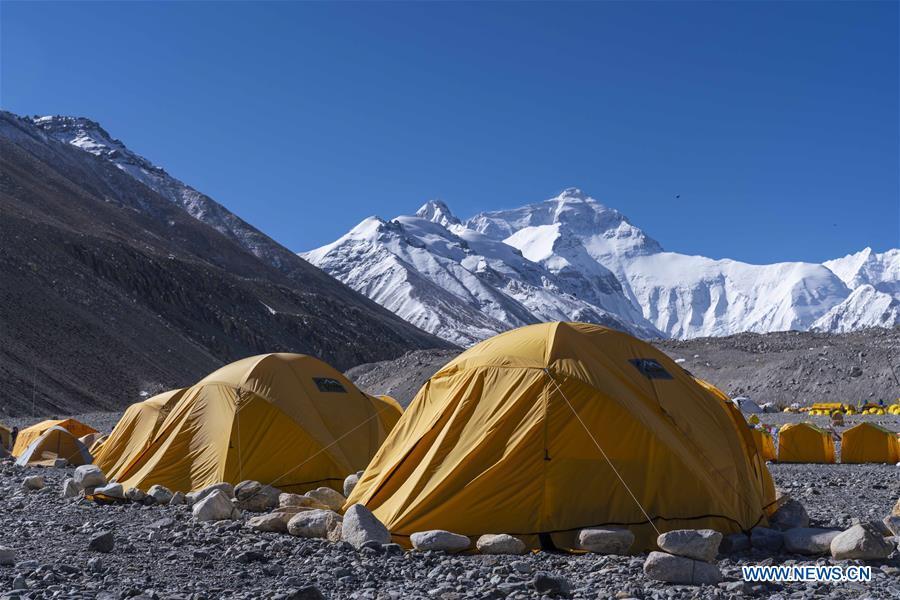
Tents of expedition teams are seen at the base camp of the northern face of Mount Qomolangma in southwest China's Tibet Autonomous Region, April 25, 2019. (Xinhua/Sun Fei)
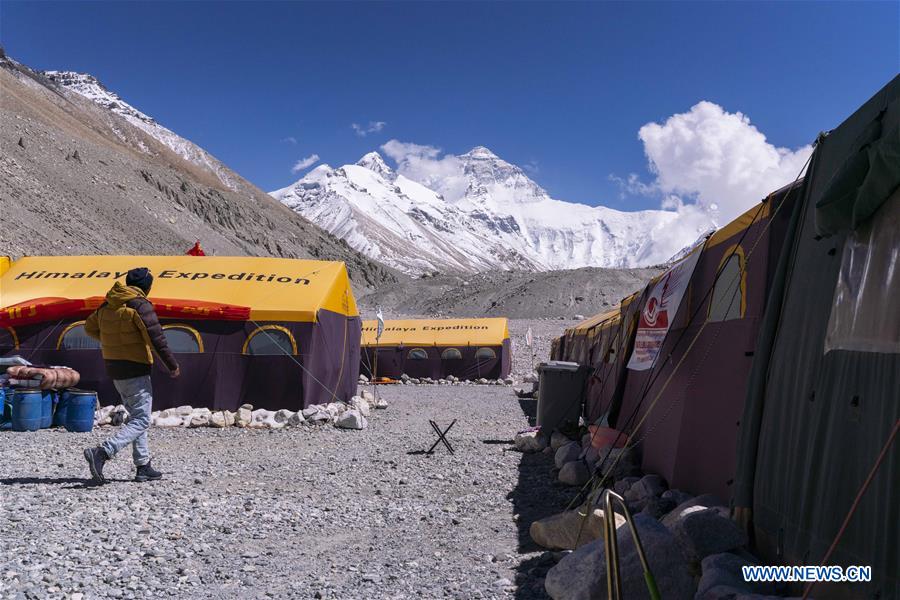
The Chinese mountaineering camp is seen at the base camp of the northern face of Mount Qomolangma in southwest China's Tibet Autonomous Region, April 26, 2019. (Xinhua/Sun Fei)
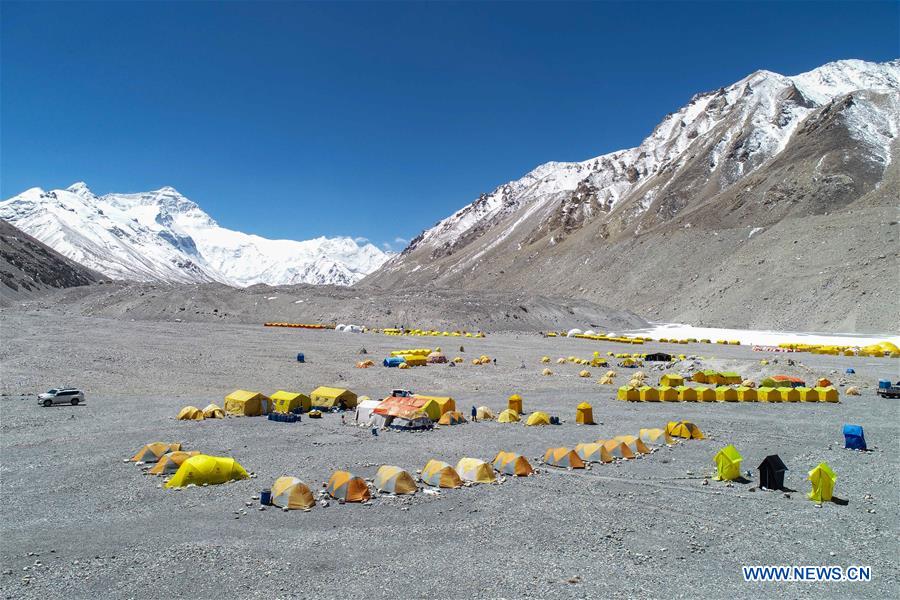
Aerial photo taken on April 25, 2019 shows the base camp of the northern face of Mount Qomolangma in southwest China's Tibet Autonomous Region. (Xinhua/Sun Fei)

Aerial photo taken in southwest China's Tibet Autonomous Region on April 26, 2019 shows scenery of Mount Qomolangma. (Xinhua/Sun Fei)


